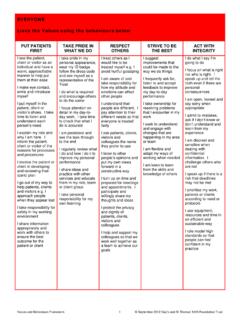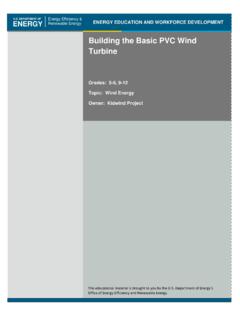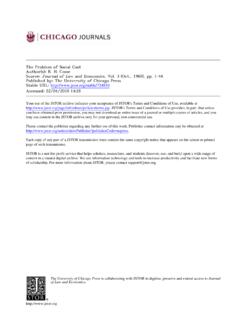Transcription of 8-bit Microcontroller Application Note
1 1 AVR035: efficient C Coding for AVRF eatures Accessing I/O Memory Locations Accessing Memory Mapped I/O Accessing Data in Flash Accessing Data in EEPROM Creating EEPROM Data Files efficient Use of Variables and Data Types Use of Bit-field and Bit-mask Use of Macros and Functions Eighteen Ways to Reduce Code Size Five Ways to Reduce RAM Requirements Checklist for Debugging Programs Updated to Support IAR Version 2 CompilersIntroductionThe C High-level Language (HLL) has become increasingly popular for programmingmicrocontrollers. The advantages of using C compared to Assembler are numerous:Reduced development time, easier maintainability and portability, and easier to reusecode.
2 The penalty can be larger code size and as a result of that often reduced reduce these penalties the AVR architecture is tuned to efficiently decode and exe-cute instructions that are typically generated by C compilers. The C Compiler development was done by IAR systems before the AVR architectureand instruction set specifications were completed. The result of the co-operationbetween the compiler development team and the AVR development team is a micro-controller for which highly efficient , high performance code is Application note describes how to utilize the advantages of the AVR architectureand the development tools to achieve more efficient C code than for any Tuned for C CodeThe 32 working registers is one of the keys to efficient C coding.
3 These registers havethe same function as the traditional accumulator, except that there are 32 of them. Inone clock cycle, AVR can feed two arbitrary registers from the Register File to theALU, perform an operation, and write back the result to the Register data are stored in the 32 working registers there are no need to move the datato and from memory between each arithmetic instruction. Some of the registers canbe combined to 16-bits pointers that efficiently access data in the data and programmemories. For large memory sizes the memory pointers can be combined with a third8-bit register to form 24-bits pointers that can access 16M bytes of data, with MicrocontrollerApplication NoteRev.
4 1497D AVR 01/042 AVR035 1497D AVR 01/04 Addressing ModesThe AVR architecture has four memory pointers that are used to access data and Pro-gram memory. The Stack Pointer (SP) is dedicated for storing the return address afterreturn from a function. The C compiler allocates one pointer as parameter Stack. Thetwo remaining pointers are general purpose pointers used by the C Compiler to load andstore data. The example below shows how efficiently the pointers are used for typicalpointer operations in *pointer1 = char *pointer2 = &table[49];*pointer1++ = *--pointer2;This generates the following Assembly code:LD R16,-Z ; Pre-decrement Z pointer and load data ST X+,R16 ; Store data and post incrementThe four pointer addressing modes and examples are shown below.
5 All pointer opera-tions are single-word instructions that execute in two clock Indirect addressing: For addressing of arrays and pointer variables:*pointer = 0x00;2. Indirect addressing with displacement: Allows accesses to all elements in a structure by pointing to the first element and add displacement without having to change the pointer value. Also used for accessing variables on the software stack and array Indirect addressing with post-increment: For efficient addressing of arrays and pointer variables with increment after access:*pointer++ = 0xFF;4.
6 Indirect addressing with pre-decrement: For efficient addressing of arrays and pointer variables with decrement before access:*--pointer = 0xFFThe pointers are also used to access the Flash Program memory. In addition to indirectaddressing with pointers, the data memory can also be accessed by direct gives access to the entire data memory in a two-word for 16-/32-bit VariablesThe AVR instruction set includes special instructions for handling 16-bit numbers. Thisincludes Add/Subtract Immediate Values to Word (ADIW, SBIW). Arithmetic operationsand comparison of 16-bit numbers are completed with two instructions in two clockcycles.
7 32-bit arithmetic operations and comparison are ready in four instructions andfour cycles. This is more efficient than most 16-bit AVR 01/04C Code for AVRI nitializing the Stack PointerAfter Power-up or RESET the Stack Pointer needs to be set up before any function iscalled. The linker command file determines the placement and size of the Stack configuration of memory sizes and Stack Pointer setup is explained in applicationnote AVR032: Modifying Linker Command Files .Accessing I/O Memory LocationsThe AVR I/O Memory is easily accessed in C.
8 All registers in the I/O Memory aredeclared in a header file usually named , where xxxx is the AVR part code below shows examples of accessing I/O location. The assembly code gener-ated for each line is shown below each C code line.#include < > /* Include header file with symbolic names */__C_task void main(void){char temp; /* Declare a temporary variable*//*To read and write to an I/O register*/temp = PIND; /* Read PIND into a variable*/// IN R16,LOW(16) ; Read I/O memoryTCCR0 = 0x4F; /* Write a value to an I/O location*/// LDI R17,79 ; Load value// OUT LOW(51),R17 ; Write I/O memory/*Set and clear a single bit */PORTB |= (1<<PIND2).}
9 /* PIND2 is pin number( )in port */// SBI LOW(24),LOW(2) ; Set bit in I/OADCSR &= ~(1<<ADEN); /* Clear ADEN bit in ADCSR register */// CBI LOW(6),LOW(7) ; Clear bit in I/O/* Set and clear a bitmask*/DDRD |= 0x0C; /* Set bit 2 and 3 in DDRD register*/// IN R17,LOW(17) ; Read I/O memory// ORI R17,LOW(12) ; Modify// OUT LOW(17),R17 ; Write I/O memoryACSR &= ~(0x0C); /* Clear bit 2 and 3 in ACSR register*/// IN R17,LOW(8) ; Read I/O memory// ANDI R17,LOW(243) ; Modify // OUT LOW(8),R17 ; Write I/O memory/* Test if a single bit is set or cleared */if(USR & (1<<TXC)) /* Check if UART Tx flag is set*/{PORTB |= (1<<PB0);// SBIC LOW(11),LOW(6) ; Test direct on I/O// SBI LOW(24),LOW(0)4 AVR035 1497D AVR 01/04while(!)}
10 (SPSR & (1<<WCOL))) ;/* Wait for WCOL flag to be set */// ?0003:SBIS LOW(14),LOW(6); Test direct on I/O// RJMP ?0003/* Test if an I/O register equals a bitmask */if(UDR & 0xF3) /* Check if UDR register "and" 0xF3 is non-zero {}// IN R16,LOW(12) ; Read I/O memory// ANDI R16,LOW(243) ; "And" value// BREQ ?0008 ; Branch if equal//?0008:}/* Set and clear bits in I/O registers can also be declared as macros */#define SETBIT(ADDRESS,BIT) (ADDRESS |= (1<<BIT))#define CLEARBIT(ADDRESS,BIT) (ADDRESS &= ~(1<<BIT))/* Macro for testing of a single bit in an I/O location*/#define CHECKBIT(ADDRESS,BIT) (ADDRESS & (1<<BIT))/* Example of usage*/if(CHECKBIT(PORTD,PIND1)) /* Test if PIN 1 is set*/{CLEARBIT(PORTD,PIND1); /* Clear PIN 1 on PORTD*/}if(!












![arXiv:1512.00567v3 [cs.CV] 11 Dec 2015](/cache/preview/e/9/b/2/7/3/a/d/thumb-e9b273ad52b2edb6f94a58f5caa30476.jpg)


